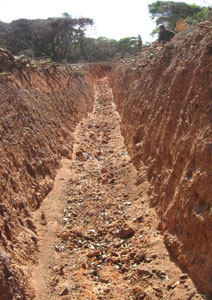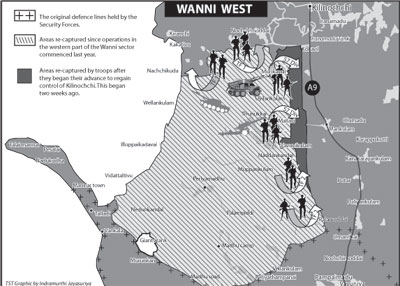A few hundred metres ahead of Kilinochchi town, behind a cadjan thatched fence, lay a central kitchen, perhaps the largest in the Wanni.
Run by the Liberation Tigers of Tamil Eelam (LTTE) the food cooked there is served not only to their cadres. Until the Government ban on visits by diplomats, the media and other visiting dignitaries food was also dished out from here. The fare would have matched any five star hotel cuisine in Colombo. Stewards in long sleeve white shirt and black bow tie served them.
This week, as artillery shells began to fall in Kilinochchi, the guerrillas were dismantling the central kitchen. Food stocks, utensils, cooks and staff were all being moved hurriedly to a secret location southwards. It is said to be deep in the guerrilla-dominated territory east of the A-9 highway.
That action by the guerrillas characterised the mood in Kilinochchi, the centre of political power of the LTTE. It is from here they ran a virttual “parallel administration”. They had included "police stations, courts and fund-raising units akin to Customs." Like their main kitchen, the guerrillas are dismantling their offices too and moving all belongings to safer areas. Thousands of Internally Displaced Persons (IDPs) who converged on Kilinochchi after the security forces moved into vast areas west of the A-9 highway in the Wanni, were ordered this week to leave immediately.
They were finding makeshift accommodation in vast stretches of open, barren land southeast of Mullaitivu. The areas include Vattakahchi, Ramanathapuram, Dharmapuram, Viswamadu, Udayarkattu and Puthukudiyiruppu.
Evacuating the civilians and dismantling their political infrastructure in Kilinochchi is not to say the guerrillas are making plans for a hasty withdrawal. Instead, they are pouring in cadres from other areas, hurriedly constructing new defences and distributing fresh military supplies for last-ditch battles. The fact that the security forces are on their doorstep is telling on them.
The hectic preparations have somewhat slowed down other regular guerrilla activity, particularly feeding websites overseas with pictorial coverage. Internet and telephone services have come to a standstill after shops in Kilinochchi were ordered to close down. At least 60 per cent of civilians (in the stretch from Old Murugandi northwards upto Pandiyan Restaurant in the Kilinochchi town) have left the area. Of some 5,000 telephones in the area, only two or three assigned to Government officials were in working order yesterday.
Early this week the security forces fought bitter battles in the Akkarayan area. Like in early September, both sides suffered heavy casualties. However, troops of the Army's 57 Division later fought their way seizing control of more territory and advancing further towards the A-9 highway. This was by smashing through guerrilla defences at Jayapuram. Yesterday they were only one and half kilometres from Kokavil, a small township on this highway. Their advance thereafter, past Iranamadu will take them to Kilinochchi. The distance from Kokavil to Kilinochchi is 22 kilometres.
In the light of guerrilla preparations to offer stiff resistance to the troops advance to Kilinochchi, it is not clear exactly how much time they would take to complete their task.
Perhaps President Mahinda Rajapaksa took these ground realities into mind when he told members of the Foreign Correspondents Association at a dinner this week that troops would seize control of Kilinochchi by December this year. "We will hopefully take Kilinochchi by December. The rest of the North, as soon as possible. I cannot give an exact time frame," he told them. However, some senior Army officers differ from their Commander-in-Chief. They contend that the task could be accomplished much earlier.
In the western flank of the Wanni, troops have formed a broad front southwards from the general area of Kokavil to south of Palamoddai where the defence lines that straddle the entry-exit point at Omanthai are located. This front faces the A-9 highway and serves as a "blockade" of the guerrilla-dominated Wanni region from the west. See map on this page.
In the north, the guerrillas have their fortified defences at Muhamalai. In April, this year, they repulsed a move by the Army to advance causing heavy casualties. The Army's 59 Division is thrusting forward from south of the guerrilla-dominated Wanni. However, this troop advance north of the Weli Oya sector has a considerable distance to go before they reach guerrilla fortifications.
Here again the troops advancing northwards have resorted to another move. They have also extended their thrust sideways. On the eastern flank they have thus succeeded in reaching the area south of the Nayaru lagoon thus reaching the coast. On the western flank, after reaching the edges of Tannimuruppukulam, they are moving in a westerly direction towards Otiyamalai area. The troop consolidation in this sector will also take the form of a "blockade" denying guerrillas a land based route to traverse to the eastern province. See map on this page.
 |
| This lengthy trench had been cut by Tiger guerrillas to serve as an obstacle to prevent troop advance. |
Besides the general area near west of Kokavil, the other sector in western Wanni where bitter battles are being fought is the area south of Nachchikuda, once home for a major Sea Tiger base. A week ago, the guerrillas prevented at least two attempts by troops to regain control of Nachchikuda and advance beyond.
This is on a broad flank extending from the coast to areas near Vannerikulam located inland.
The guerrillas have in the past months constructed a mound with a huge ditch to stall the advancing troops. This mound is said to extend for many miles eastwards from Nachchikuda. In this sector, troops are only some 30 kilometres away from Pooneryn. As pointed out earlier, years ago a ferry service operated from Sangupiddy (on the Pooneryn side) across the Kilali lagoon to Karativu, south of the Jaffna peninsula. A troop success in this area, the Army believes, would pave the way to establish a land based route from Mannar to Jaffna.
Reports from the north this week say the guerrillas have heavily fortified the area with more cadres. They have moved large stocks of military supplies including mortars. This has fuelled suspicions in sections of the security establishment whether the guerrillas were planning to use the Pooneryn area to mount a major attack on troops advancing towards Nachchikuda.
Early this week, troops and police countrywide were placed on "red alert," the highest level of security preparedness. This followed intelligence reports of a possible land, air attack, or both, by Tiger guerrillas.
In my account last week on the guerrilla ground, artillery and air attack on the Security Forces Headquarters - Wanni (SFHQ -W) I had erred. I said that the Indian built Indra II radar was named after the late Indian Prime Minister, Indira Gandhi. This is wrong. The name Indra is an acronym for Indian Doppler Radar manufactured by Bharat Electronics Ltd. in Bangalore. Besides the Sri Lanka Air Force, the Indian Air Force and the Indian Army use these radars.
The Air Force has appointed a Court of Inquiry headed by Group Captain Romesh Fernando, Commanding Officer of the SLAF base in Vavuniya, to probe this attack. Among other matters they will identify any security lapses and measures needed to rectify them. The guerrilla attack in Vavuniya on September 9 was no doubt intended on causing damage to the Indra II radar unit at the SFHQ - W. There were also other equally important related targets which cannot be detailed out for reasons now obvious. Sections of the security forces in the north are examining another reason that may have prompted this attack. There were reports, though not confirmed, that the guerrillas were smuggling a consignment of military hardware.
This week's battles show that the ongoing Eelam War IV is reaching an even fiercer phase. For the security forces, seizing Kilinochchi would only be just one step away from Mullaitivu, the military fortress of the guerrillas.
The fact that the guerrillas will offer heavy resistance is no secret. Their capability in this regard should not be underestimated.
The Ceasefire Agreement of February 2002 helped them to chalk out a vast swathe of territory in the Wanni. It has now shrunk. The resistance the guerrillas have offered in the recent weeks to prevent troops entering their strongholds shows they still have a military capability despite all the claims that eighty per cent of their cadres have been wiped out. |



